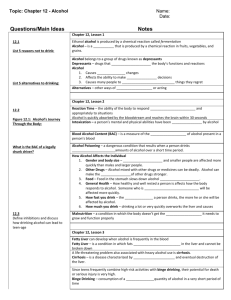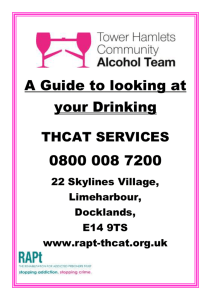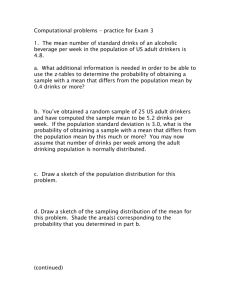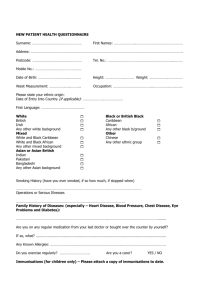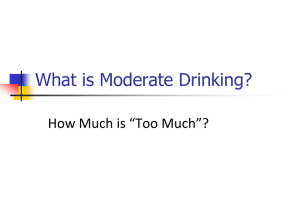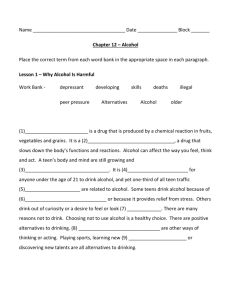Section 3 - Types of Alcoholics and Stages of
advertisement
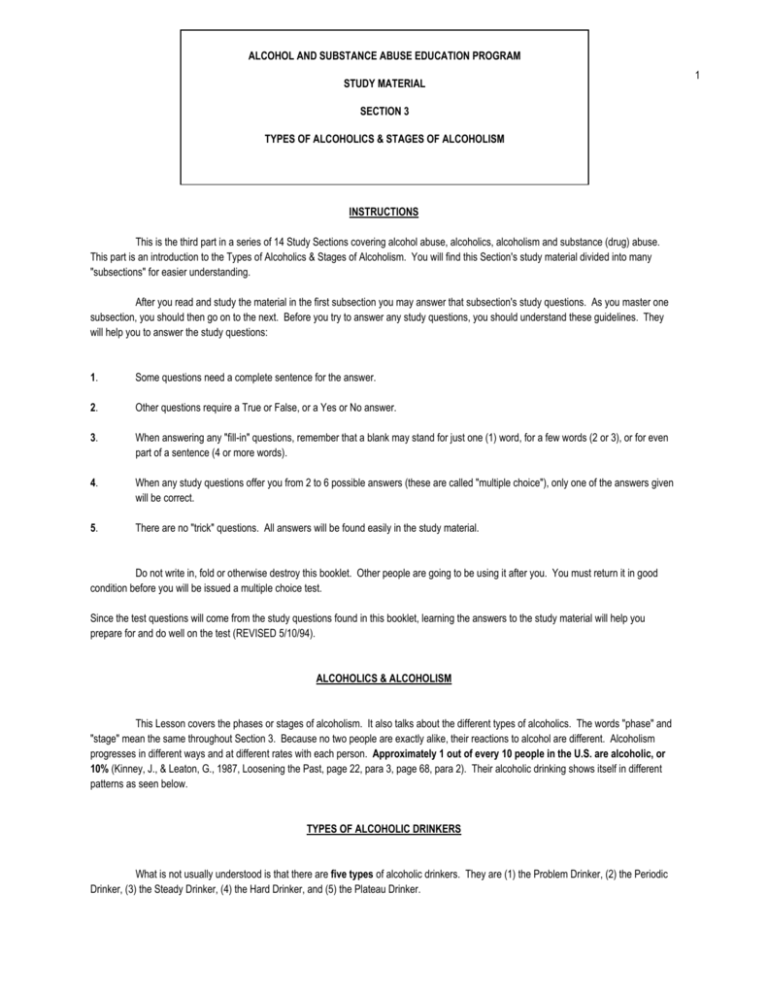
ALCOHOL AND SUBSTANCE ABUSE EDUCATION PROGRAM STUDY MATERIAL SECTION 3 TYPES OF ALCOHOLICS & STAGES OF ALCOHOLISM INSTRUCTIONS This is the third part in a series of 14 Study Sections covering alcohol abuse, alcoholics, alcoholism and substance (drug) abuse. This part is an introduction to the Types of Alcoholics & Stages of Alcoholism. You will find this Section's study material divided into many "subsections" for easier understanding. After you read and study the material in the first subsection you may answer that subsection's study questions. As you master one subsection, you should then go on to the next. Before you try to answer any study questions, you should understand these guidelines. They will help you to answer the study questions: 1. Some questions need a complete sentence for the answer. 2. Other questions require a True or False, or a Yes or No answer. 3. When answering any "fill-in" questions, remember that a blank may stand for just one (1) word, for a few words (2 or 3), or for even part of a sentence (4 or more words). 4. When any study questions offer you from 2 to 6 possible answers (these are called "multiple choice"), only one of the answers given will be correct. 5. There are no "trick" questions. All answers will be found easily in the study material. Do not write in, fold or otherwise destroy this booklet. Other people are going to be using it after you. You must return it in good condition before you will be issued a multiple choice test. Since the test questions will come from the study questions found in this booklet, learning the answers to the study material will help you prepare for and do well on the test (REVISED 5/10/94). ALCOHOLICS & ALCOHOLISM This Lesson covers the phases or stages of alcoholism. It also talks about the different types of alcoholics. The words "phase" and "stage" mean the same throughout Section 3. Because no two people are exactly alike, their reactions to alcohol are different. Alcoholism progresses in different ways and at different rates with each person. Approximately 1 out of every 10 people in the U.S. are alcoholic, or 10% (Kinney, J., & Leaton, G., 1987, Loosening the Past, page 22, para 3, page 68, para 2). Their alcoholic drinking shows itself in different patterns as seen below. TYPES OF ALCOHOLIC DRINKERS What is not usually understood is that there are five types of alcoholic drinkers. They are (1) the Problem Drinker, (2) the Periodic Drinker, (3) the Steady Drinker, (4) the Hard Drinker, and (5) the Plateau Drinker. 1 2 These alcohol abusers can be found in any of the four stages of Alcoholism. These stages are marked by different levels of loss of control and drunken actions. Each alcoholic stage may have one or more Steps in it. The steps within a stage and the phases themselves are not "exact". There can be overlapping or mixing of symptoms between steps (Kinney, J., & Leaton, G., 1987, Loosening the Past, page 56-57, top and bottom). The types of alcoholic drinkers and the stages of alcoholism were developed after much research by Dr. E. M. Jellinek. Because Dr. Jellinek discovered these different stages, alcoholism in some cases has been called "Jellinek's Disease". (Kinney, J., & Leaton, G., 1987, Loosening the Grip, page 59, bottom para). STUDY QUESTIONS 1. There are ___________________ types of alcoholics. 2. There are ___________________ stages of alcoholism. STUDY QUESTIONS 3. There can be ________________ between steps and phases. 4. The types of alcoholics and the phases of alcoholism were developed by Dr. _____________________________. 5. _______________________ has been called "Jellinek's Disease". TYPES OF DRINKERS As stated above, although there are many types of drinkers, for the most part they fall into five (5) identifiable categories. These categories are based on the way drinkers drink. Let's take a look now at the five major types of drinkers: 1. THE PROBLEM DRINKER The Problem Drinker is a type of drinker who has a psychological dependence on alcohol. He often drinks to get rid of emotional, social or bodily problems. He may drink a lot, but at this point he is not addicted to alcohol. This means he does not "need" to drink. The two most important features of Problem Drinkers are (1) when they do drink they develop problems. Second, (2) they get into much more trouble when they are drinking than when they are sober. The Problem Drinker often runs into trouble in one or more areas of life. These problems often include: family problems, relationship problems, financial problems, employment troubles, and trouble with the law. The Problem Drinker can control the amount of alcohol he drinks. In this stage, this person is not and may never become physically addicted to alcohol. He does, however, abuse alcohol. He has the same 10% chance of becoming an alcoholic as the rest of the population. The problem drinker may not be an alcoholic. However, almost all alcoholics start off in this stage, then move on to deeper stages of alcohol dependence. 3 STUDY QUESTIONS 1. The ______________________ Drinker has a psychological dependence on alcohol. STUDY QUESTIONS 2. Do Problem Drinkers develop problems and get into trouble when they drink? (Yes or No) 3. Problem Drinkers can have problems with (a) family and friends, (b) money and work, (c) the law, or (d) all of these. 4. The Problem Drinker cannot control his drinking and becomes addicted to alcohol. (True or False) 2. THE PERIODIC DRINKER The Periodic Drinker is the second type of drinker. He is often known as the "binge drinker". While he may stay sober for a very long time, when he does start drinking he has trouble quitting. He will often keep drinking and stay drunk for several days in a row. In between drinking binges, he usually does not drink any alcohol at all for long periods of time. The length of time he drinks when he does binge varies from drinker to drinker. These drinkers will also vary in the amount of time they stay sober between drinking binges. Often the Periodic Drinker will have mood swings. He may go from being very happy to very depressed. This drinker often begins drinking when he gets into a low mood or depressed. He does this in order to try and stop the emotional pain. The more he drinks, the more the alcohol makes him depressed. He often suffers from loss of control over his drinking and short term addictive behavior. This means when he does start drinking he has trouble quitting. Often these drinkers start drinking on weekends. The weekend drinking then spreads into Friday nights. Hangovers on Monday mornings usually make the Periodic Drinker late for work. When the drinker does get to work, he is often not worth much as a worker. He feels bad from all the weekend drinking. STUDY QUESTIONS 1. The (Problem, Periodic) Drinker is known to "binge". 2. The binge drinker usually (a) stays drunk for days in a row, (b) can go long periods without alcohol, (c) can binge once a year, or (d) all of these. 3. When he does start drinking, he has trouble _________. STUDY QUESTIONS 4. ___________________Drinkers usually drink on (a) holidays, (b) weekends, (c) at work, or (d) a & b. 5. When the periodic drinker experiences mood swings, he may go from being very _________ to very ___________. 4 3. THE STEADY DRINKER The Steady Drinker is the drinker most people think of when they think of "alcoholics". The most common type alcoholic is the Steady Drinker. These people drink most of the time. They have a true physical addiction to alcohol. This means they have more and more of a loss of control over the amount of alcohol they drink. If they run out of alcohol for any reason, they begin to crave it. If they cannot get it, they start to go into withdrawal. They also have an increased tolerance for alcohol. This means that it takes much more alcohol to get them drunk than it used to. It also takes much more alcohol to get them drunk than it does most other people. This drinker often looks sober after drinking large amounts of alcohol that would make most normal people pass out. Often this drinker suffers from physical problems. Their health suffers from drinking too much. Some of these drinkers may never get drunk, but they can always be found sipping on an alcoholic drink. You do not always have to be drunk to be an alcoholic, although that is what usually happens. STUDY QUESTIONS 1. The most common type of alcoholic is the Steady Drinker. (True or False) 2. Steady Alcoholic Drinkers, (a) drink most of the time, (b) are addicted to alcohol, (c) lose control over the quantity of alcohol they drink, or (d) all of these. 3. Steady Alcoholic Drinkers have an increased _______________ for alcohol, suffer from __________________, and are always __________________. 4. THE HARD DRINKER The Hard Drinker usually has many nutritional problems. (Blum, K., 1984, Handbook of Abusable Drugs, page 262 para 1). This is due to the alcoholic not eating wholesome foods which give him the vitamins and minerals he needs (Young, L., Klein, M., & Beyer, D.,1977, Recreational Drugs, page 7, para 2). Since the body treats alcohol like a junk food and burns it, the drinker does not get very hungry. This means that he often does not eat. Although alcohol can be used by the body to burn, it is the worse of junk foods. Alcohol has many calories, but no vitamins, minerals or protein that the body needs to stay healthy (Kinney, J., & Leaton, G., 1987, Loosening the Grip, page 32, para 2), (Young, L., Klein, M., & Beyer, D., 1977, Recreational Drugs, page 7, para 2-3). Nutritional deficits plus a suppression of the body's immune system add up to cause the alcoholic many health problems. When we say suppression of the immune system, this means that the natural defenses that the body uses to ward off sicknesses are knocked out. When this system of your body is harmed by drinking too much alcohol, you will end up getting sick more often. Alcohol itself often does many other types of damage to the body (Blum, K., 1984, Handbook of Abusable Drugs, page 252, para 1). Heavy drinking often causes cirrhosis of the liver, or liver disease (Kinney, J., & Leaton, G., 1987, Loosening the Grip, page 99, para 3). It will also cause gastritis (swollen or inflamed stomach or intestinal lining) (Kinney, J., & Leaton, G., 1987, Loosening the Grip, page 61, graph), (Spenco Medical) (Young, L., Klein, M., & Beyer, D., 1977, Recreational Drugs, page 6 para 2). The hard drinker has lost control of his drinking. This type of drinker is considered an "addicted alcoholic". These drinkers usually do not eat much because they are always drinking. If they have one problem they usually have many problems. Generally, they do not live as long as a person who does not drink (Young, L., Klein, M. & Beyer, D., 1977, Recreational Drugs, page 7, para 2). The Hard Drinker is addicted and literally craves alcohol. In other words, the alcohol has control over him, not the other way around. 5 STUDY QUESTIONS 1. The ______________________ Drinker has _______________ problems due to lack of ________________ foods. 2. Hard Drinkers (are, are not) addicted to alcohol. 3. Hard Drinkers (do, do not) experience liver diseases, gastritis, nervousness and other physical problems. STUDY QUESTIONS 4. These drinkers have (a) long life expectancy, (b) very few problems, (c) no craving or addiction to alcohol, or (d) none of these. 5. THE "PLATEAU" ALCOHOLIC DRINKER The Plateau Drinker is known for his need to keep a certain minimum level of alcohol in his body most of the time. When something hits a plateau, it usually climbs and then it levels off and does not go any higher. Plateau drinkers usually do not look drunk, although they often smell from alcohol. Their tolerance levels are very high. This means that it takes much more alcohol to get them "high" and to keep them "high" than for most people. Often the social life of this alcoholic has collapsed long ago. They have many health problems. They cannot control how much alcohol they drink. Often, they drink as much as they can get. If they do not keep a large amount of alcohol in their bloodstream, they will go into withdrawal, and they can die from this withdrawal (Kinney, J., & Leaton, G., 1987, Loosening the Grip, page 120, para 2)., Inaba, D., & Cohen, W., 1990, Uppers, Downers, All Arounders, pages 43-44-45) (Blum, K., 1984, Handbook of Abusable Drugs, page 265 total page). STUDY QUESTIONS 1. The __________________ Drinker keeps alcohol in his body most of ___________________. 2. If Plateau Drinkers do not keep lots of alcohol in their system, they could go into ____________ and they (could, could not) die. THE STAGES OF ALCOHOLISM Most Alcoholic drinkers go through a series of four stages. These stages progressively get worse as time passes. They move from controlled social drinking (the First Stage), to a complete loss of control over drinking (the Second & Third Stages). They end addicted to alcohol in (the Fourth Stage). The following outline chart will help you to understand the individual Stages and Steps in each Stage: STAGE NUMBER. SOMEONE IN THIS. STEP NUMBERS & CONDITIONS STAGE IS CALLED. __________________________________________________________ First Stage. Pre-Alcoholic . 1. Controlled Drinking . . 2. Occasional Escape . . Drinking. 6 . . 3. Frequent Escape . . Drinking. __________________________________________________________ Second Stage. Early Alcoholic . 4. Blackout or . . Pre-occupation ___________________________________________________________ Third Stage. True Alcoholic . 5. Alcohol is ALL. __________________________________________________________ Fourth Stage. Chronic . 6. Alcohol Dependence . Alcoholic . 7. Delirium Tremens These four (4) Stages and (7) Steps are described in detail below: (Kinney, J., & Leaton, G., 1987, Loosening the Grip, pages 56-57, total page). THE FIRST STAGE THE PRE-ALCOHOLIC STAGE (Steps 1, 2 & 3) STEP 1, CONTROLLED DRINKING: With "controlled" or "social" drinking, this individual goes to a lot of parties and social events. He does not usually drink enough to become very drunk at first. This Stage is marked by a slow and steady increase in the number of times he does get drunk. This is the start of the alcoholic process. From this point it often takes several years for the alcoholic to begin to seriously lose control. It is in this Stage, however, that he will insist that he drinks just because he wants to. He will say that he can stop drinking whenever he wants to, but he just does not want to. A true test of how far gone he is would be to ask the drinker to stop drinking for one month. How much trouble he has stopping is an indication of how far along he is or whether he can actually stop at all. If he is not depending on alcohol, he will be able to stop with no problem and without excuses. If he is depending on alcohol, he will make excuses and keep drinking. He is afraid to take a real look at actually how dependent he has become on alcohol. STEP 2, OCCASIONAL ESCAPE DRINKING: (pre-alcoholic). This drinker chooses to "occasionally" escape from his problems and tensions by drinking (Kinney, J., & Leaton, G., 1987, Loosening the Grip, page 57, para 1). In the second stage, the alcoholic not only drinks because he gets relief from his problems, but also because alcohol is starting to become a crutch to him. His dependence on alcohol is a slowly growing process. He first starts drinking to deal with problems and tensions. Later on, he uses drinking to purposely escape from all of life's problems (Kinney, J., & Leaton, G., 1987, Loosening The Grip, page 57, para 1). More times he uses alcohol to avoid problems, the worse those problems become. This drinker will then usually drink even more. The more he drinks, the worse his problems become (Kinney, J., & Leaton, G., 1987, Loosening the Grip, page 57, para 1). During periods of drunkenness, he cannot learn the lessons life has to teach him. He stops growing mentally and emotionally when he starts using alcohol to solve his problems. It is usually in this Step that the Problem Drinker is first found. STEP 3, FREQUENT ESCAPE DRINKING: This third Step happens so slowly that the drinker is usually not even aware of what is happening to him. In this Step the drinker frequently uses alcohol to escape from the problems of life in general. They drink more and more often. The more they drink, the weaker their coping skills become. They become more and more dependent on alcohol to solve all their problems for them. They become less efficient at solving their own problems (Kinney, J., & Leaton, G., 1987, Loosening the Grip, page 57, para 1). 7 They start relying on other people to do more and more for them. The more others do for them, the more dependent they become. The more dependent they become on other people, the more they dislike themselves and the people they are dependent on. They also become a great burden to other people. Other people who do not drink as much start staying away from them. The drinker has to start hanging around with people who drink as much as he does in order to find company. These other drinkers tell the him that it is o.k. to drink as much as he wants. They all drink together, and they all sink together. They convince each other that it is o.k. to drink as much as they want to. They are like a ship of fools, all sinking together. During these three Steps of the Pre-Alcoholic Stage, the amount of alcohol these individuals need to use to get high increases (Kinney, J., & Leaton, G, 1987, Loosening the Grip, page 57, para 2). This amount increases so slowly over time that they can hardly notice that alcohol is taking control of them. This is called "tolerance". In other words, the more alcohol that is consumed, the more it takes to have the same effect over time. The body gets used to alcohol very slowly (Blum, K., 1984, Handbook of Abusable Drugs, page 260, para 2-5). It is usually during Step 3 that a noticeable increase in, the amount of alcohol needed is seen. As the alcoholic’s body develops a tolerance for alcohol, it becomes necessary for him to drink more alcohol to achieve the same high or "buzz" that he experienced before. STUDY QUESTIONS 1. The Pre-Alcoholic Stage consists of (a) controlled drinking, (b) escape drinking, (c) neither a nor b, or (d) both a & b. 2. In which Step (1, 2 or 3) is the Problem Drinker first found? 3. In which Step (1, 2 or 3) does the drinker start drinking to cope with problems and tensions? 4. In Step 3 the drinker (is, is not) aware of what is __________________ to him. 5. During all three Steps (a) alcohol drinking increases slowly, (b) the body becomes adjusted to alcohol slowly, (c) one drinks more to "get a buzz", or (d) all of these. THE SECOND STAGE THE EARLY ALCOHOLIC STAGE (step 4) STEP 4, BLACKOUT OR PREOCCUPATION: The blackout is considered to be an early symptom of a significant problem with alcohol. The blackout may also signal one of the first stages of alcoholism (Kinney, J., & Leaton, G., 1987, Loosening the Grip, page 57, para 2). Alcohol preoccupation is when the alcoholic thinks about drinking all the time. It is usually during this Step that "blackouts" occur. This is not "passing out" from drinking too much alcohol. It is more like a temporary amnesia or short term memory loss (Kinney, J., & Leaton, 1987, Loosening the Grip. page 138-139). Blackouts usually happen after heavy drinking. As alcohol addiction progresses, blackouts often become more frequent and last longer. As a result, an alcoholic may wake one morning to find his car smashed up with blood on the fender and have no memory of what he hit. He may not even know how he got home the night before. Not everyone experiences blackouts. Blackouts however, are a serious warning sign that alcohol problems have started (Kinney, J., & Leaton, G., 1987, Loosening the Grip, page 138-141). It is in the second Stage that alcohol becomes the main interest in the life of a problem drinker. The alcoholic is constantly thinking about how to keep himself supplied with alcohol and how long his supply will last. He starts using alcohol as a crutch. He is in the process of losing control over his drinking. Often he drinks until he is too drunk or too sick to drink any more. When these type drinkers are invited to social gatherings, they are more concerned with when the drinks are being served than talking with friends (Kinney, J., & Leaton, G, 1987, Loosening the Grip, page 57, para 2). These drinkers are far past the "social drinking stage". 8 They will often gulp down several drinks before they go to a party just to get a head start on the others. They want to get their high (or buzz) as quickly as possible. These drinkers will also start drinking alone. Often, when drinking with others they may embarrass their spouse or friends. Because of the things they do while they are drunk, they start feeling guilty. They try to find acceptable reasons or excuses for the way they drink. These drinkers will often play down the amount of alcohol they drink and lie about the number of drinks they have had. The alcoholic has by this time started making up "rules" in an attempt to control his drinking. These rules might go something like, "I won't drink before noon". "I'll just drink beer and no hard stuff". "I'll just drink at mealtime". "I won`t drink alone". The common thing about all these rules is that they do not work. These rules are usually broken at the very first excuse the drinker can find. The Early Alcoholic may go "on the wagon" for short periods of time (Kinney, J., & Leaton, G., 1987, Loosening the Grip, page 59, para 2). This means he will force himself to stop drinking. This is only an attempt to prove to himself and to everyone else that he has some control over his drinking. Sometimes they avoid alcohol for as long as two or three weeks. But, as soon as they take the very next drink, they lose control and start drinking heavily again. Nothing has really changed. As soon as they start drinking again, their tolerance to alcohol continues to increase. As they continue to drink, they lose more and more control over alcohol and themselves. STUDY QUESTIONS 1. Step 4 covers blackouts or preoccupation. (True or False) 2. The Early Alcoholic may experience (a) blackouts, (b) (c) temporary amnesia, (c) a smashed-up car, or (d) all of these. 3. The main interest of the ______________ is alcohol. 4. When Early Alcoholics go to social events, they (a) chat with friends, (b) drink slowly, (c) are courteous, or (d) none of these. 5. While Early Alcoholics may play down the amount of alcohol they drink, they do not stoop to lying about how many drinks they've had. (True or False) 6. These alcoholics make up easy rules and usually do not break them in an attempt to control their drinking. (True or False) 7. Early Alcoholics may (a) go "on the wagon" indefinitely, (b) gain control over their drinking, (c) avoid alcohol for a few weeks, or (d) none of these. 8. Even if an early alcoholic stays off alcohol for two weeks, months, or even years, as soon as he takes the very next drink, he will be drinking heavily again. (True or False) 9. Early Alcoholics often start making up rules in an attempt to control their drinking. True or False THE THIRD STAGE THE TRUE ALCOHOLIC STAGE (Step 5) STEP 5, "ALCOHOL IS All": (Let us once again make it clear that the phases are not definite periods of time. There are no identifiable symptoms or specific physical conditions connected to each phase) (Kinney, J., & Leaton, G., 1987, Loosening the Grip, page 57, para 1). Over a period of time the crucial phase becomes the True Alcoholic Stage. The amount of time may be months or years. If you have a 9 family history of alcoholism, often you will tend to lose control over your drinking faster. It is at this stage that everything revolves around alcohol. Nothing is more important in the life of a third stage alcoholic than alcohol. The True Alcoholic will give up everything in order to keep drinking. He will neglect his appearance, job, family, home, friends, church (Kinney, J., & Leaton, G., 1987, Loosening the Grip, page 58, para 1-2). Virtually everything will go ignored if it interferes with his drinking. Often, third stage drinkers who are married, end up in divorce. They experience much guilt, anger, fear and resentment. These negative feelings lead to even more drinking, as the alcoholic tries to make him/herself feel better with alcohol. There is not much the law can do to punish the alcoholic, more than he has already punished himself by his own drinking. Throwing a person in jail only stops him from drinking for a very short period of time. He will often start again as soon as he can get his hands on alcohol again. Treatment is necessary for recovery. For this reason, education and treatment such as A.A. and group therapy, are essential for recovery. Punishment does not work well, in helping alcoholics to recover, if at all. It makes them want to drink more. It is in the True Alcoholic Stage that alcoholics cannot stop at just one drink. Their judgment becomes very bad, and they often get into trouble with the law. STUDY QUESTIONS 1. "Alcohol is all" to the ________________ Alcoholic. 2. The True Alcoholic will give up or neglect (a) his appearance, (b) his job, (c) his home & family, or (d) all of these. 3. These alcoholics (a) feel guilt, anger & fear, (b) can be rehabilitated by prison, (c) can stop at one drink, or (d) have good judgment and avoid problems with the law. 4. For the ___________________ education and ____________ are essential for recovery. THE FOURTH STAGE THE CHRONIC ALCOHOLIC STAGE (Steps 6 & 7) STEP 6, COMPLETE ALCOHOL DEPENDENCE: The alcoholic is now at the point where he drinks for long periods of time without stopping. In this Stage the alcoholic must keep a high level of alcohol in his bloodstream, or he will start going into withdrawal (Kinney, J., & Leaton, G., 1987, Loosening the Grip, page 141, para 3). In order to do this, he may start drinking the first thing in the morning during this stage. The Chronic Alcoholic is a poor example of a human being. He is usually undernourished due to lack of proper food and vitamins. Family relationships, if still intact, are at the point of total collapse. The alcoholic at this point is a very mixed up person. He may drink for days at a time without stopping. If an alcoholic in this phase cannot afford a drink he may resort to stealing to get alcohol. Those who can't or won`t steal may start drinking other things with alcohol in them. These substitutes are often such things as shaving lotion, Sterno, cough syrup, rubbing alcohol or varnish thinner. The type of alcohol these substitutes contain is poisonous. Drinking other products with alcohol in them can blind or even kill a person drinking them. STEP 7, DELIRIUM TREMENS ("DT's"): When an alcoholic goes into DT's he is at the end of the line. Now he has to get medical help, or the alcohol may kill him in a short period of time (Kinney, J., & Leaton, G., 1987, Loosening the Grip. page 145, para 3), (Spenco Medical). 10 By this time the alcoholic most likely has many serious physical problems. These are often such things as liver damage, diseases of the pancreas and mass destruction of brain cells. Irreversible brain damage may have already taken place (Kinney, J., & Leaton, G., 1987. Loosening the Grip, pages 121-122, total page), Spenco Medical). D.T.'s happen when the alcoholic has been drinking a lot for a long time and he is suddenly cut off from getting more alcohol. DT's are a very nasty part of withdrawal. The alcoholic becomes very nervous and sick (Kinney, J., & Leaton, G., 1987, Loosening the Grip, page 143). DT's usually include vivid and terrifying auditory (hearing), visual (seeing), and tactile (feeling) hallucinations. There is also much confusion, disorientation, agitation, restlessness, fever, abnormally-rapid heartbeat and possibly seizures (Kinney, J., & Leaton, G., 1987, Loosening the Grip, page 120, para 2), (Spenco Medical). DT's do not usually occur until the alcoholic has been in the last two phases of alcoholism for several years. Symptoms of these Stages often start slowly and increase in strength and length. DT's can last from two days to two weeks. These hallucinatory episodes often end in a long period of sleeping. Without medical help, ten percent of alcoholics who go into DT's will die. If the Chronic Alcoholic happens to survive the DT's, and keeps drinking, he will eventually then have to face something just as ugly. This is a condition known as "REVERSE TOLERANCE". (Kinney, J., & Leaton, G., 1987, Loosening the Grip, page 119. para 1). At this point, the body is at the end of the amount of alcohol it can stand. The body cannot adjust to any more alcohol. If the drinker drinks the same amount of alcohol that he is used to drinking, he will get very sick. The alcoholic can no longer depend on alcohol to wipe out all his pain or what he has become. In short, alcohol will not get the drinker drunk any longer. He will get sick before he gets drunk. The drinker cannot drink as much as he had in the past, and as time passes it takes less and less alcohol to make him sick. This is one of the reasons they call this happening "reverse tolerance" because the tolerance actually reverses itself, it goes the other way. The body can handle less and less of the drug alcohol before it gets sick. This means that the once formed tolerance to alcohol has reversed itself. All of these things make up reverse tolerance (Kinney, J., & Leaton, G., 1987, Loosening the Grip, page 119, para 1). Once the Chronic Alcoholic hits the reverse tolerance stage, alcohol is no longer a choice for him. Alcohol starts making him sick before he can get drunk on it. As time passes, it takes less and less alcohol to make him sick. He cannot even get drunk anymore. He has to withdraw. He has to face what he has become sober. It is at this point where the alcoholic often ends up killing himself. He cannot use alcohol to drown out the pain any longer. His body has endured all the alcohol it can take and it will take no more. When reverse tolerance starts happening, the alcoholic usually has a "rude awakening" when he tries to drink his "regular" amount of alcohol. He gets violently ill. From then on, the amount of alcohol he can drink before he gets sick continues to decrease (Kinney, J., & Leaton, G., 1987, Loosening the Grip, page 119, para 1). He may find ten years down the road that he gets very sick after drinking just one beer. At this point the alcoholic is probably in the worst shape that he has ever been in. As stated above, if he does not receive prompt medical attention, there is a 10% chance that he will die. (That is a much higher probability of death than someone withdrawing from heroin.) STUDY QUESTIONS 1. So long as the Chronic Alcoholic keeps lots of alcohol in his bloodstream he will not go into withdrawal. (True or False) 2. The Chronic Alcoholic (a) is well fed, (b) has solid family relationships, (c) will drink substitutes even when he can afford liquor, or (d) is a poor example of a human being. 3. D.T.'s do not usually occur until the alcoholic has been in the last two phases for many years. (True or False) 4. Chronic Alcoholics who go into DT's have a ________________ chance of dying, and must receive prompt medical attention. 11 5. Once reverse tolerance hits, the alcoholic cannot get drunk without getting very sick first. (True or False) After reading about all the stages of the disease of alcoholism, it is clear that abusing alcohol can cause serious harm to the alcoholic's body, mind, social life and morals. (Kinney, J., & Leaton, G., 1987, Loosening the Grip, page 95, top to bottom). The alcoholic's body can increase or decrease in weight. He usually has poor sleeping patterns and quite often he cannot sleep (Kinney, J., & Leaton, G., Loosening the Grip, page 136, bottom para). Organs such as the liver, pancreas and brain are affected. He has a low resistance to disease and often finds that he gets sick easier and much more often (Kinney, J., & Leaton, G., 1987, Loosening the Grip, page 104, total page). Alcoholism affects his mind and emotions (Kinney, J., & Leaton, G., 1987, Loosening the Grip, page 152-153). He becomes much more sensitive about things than when he was not drinking. He is often irritable, grumpy and sometimes violent. His emotions are all mixed up and bottled up. His self-esteem has dropped to an all-time low. He does not like himself or anyone else. He often has destroyed or alienated his family (Kinney, j., & Leaton, G., 1987, Loosening the Grip, pages 165-167). His social life has also changed drastically. Instead of going to parties to meet people, he attends them just to drink. Even before the party starts he has been drinking. He changes his friends to people who also drink heavily. These drinking friends continue to convince him that it is ok to drink. He even stays away from home to avoid being "nagged" about his drinking. He changes jobs before he gets fired because of his drinking. He then tries to hide his drinking problem from his new employers. The alcoholic's morals, morality and values have also changed drastically to where he is no longer a decent or honest person. His finances deteriorate. He may find himself cheating, lying or stealing to get the money he needs to keep on drinking. He finds himself guilt ridden, angry and resentful (Kinney, J., & Leaton, G., 1987, Loosening the Grip, page 157, para 2). STUDY QUESTIONS 1. Alcohol causes harm to (a) the alcoholic, (b) his body and mind, (c) his social life and his morals (d) his emotions, or (e) all of these. 2. What usually happens to the alcoholic? (Pick one only) (a) He can lose or gain weight. (b) He can have good sleeping habits. (c) He has a high resistance to disease. (d) He does not get sick easily. (e) He becomes a "social" drinker. 3. In what areas is the alcoholic affected by alcohol? (a) His mind and emotions, (b) his sensitivity, (c) his organs, or (e) all of these. 4. Alcoholics hurt themselves in different ways: (a) they gain self-esteem, (b) they destroy their families, or (c) both a & b. REFERENCES: Kinney, J., & Leaton, G., 1987, Loosening the Grip: A handbook contains the basic information an alcohol counselor or other professional confronted with alcohol problems. C.V. Mosby Company, St. Louis, Missouri 63146. Blum, Kenneth, 1984, Handbook of Abusable Drugs: A handbook that provides the reader with a detailed critical review of the biochemical, pharmacological and sociological aspects of drugs of abuse. Gardner Press, Inc., New York, N.Y. 10003 PAMPHLETS: Spenco Medical.
